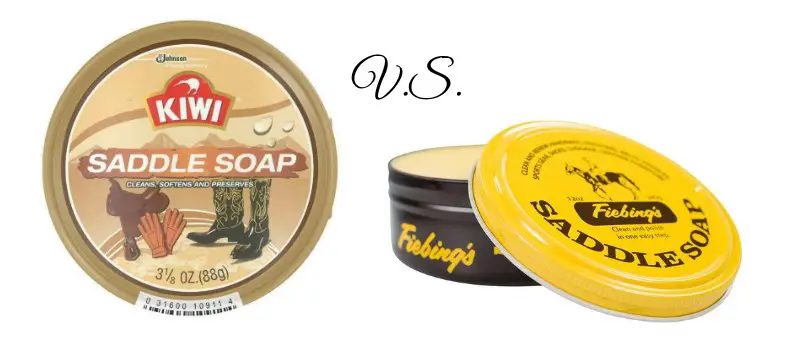Often times when I am using a product such as saddle soap I wonder if it is actually doing what it claims or if it is just snake oil. Let’s dig in together and see if we can determine what it actually is, how it’s made, and how we can make our own!
Saddle soap is a blend of preservatives, oils, and moisturizers designed to clean and protect leather. Lastly, It is meant to be a bit more aggressive than other leather cleaner and conditioners.
What is in Saddle Soap?

I took a deep look into two of the most popular soaps on the market today Kiwi Saddle Soap and Fiebing’s saddle soap. Both claim to clean and protect leather products. However, I wanted to know what was actually in them. Since both products provide an ingredient list on their websites, I was able to compile a list below.
| Kiwi | Fiebing | Ingredient | Purpose |
|---|---|---|---|
| X | Benzisothiazolinone | Preservative | |
| X | Carnauba Wax | Polish/Waterproofer | |
| X | Citronella Oil | Oil | |
| X | Diethyl phthalate | Fragrance | |
| X | Glycerin | Moisturizer | |
| X | X | Lanolin | Moisturizer |
| X | Neatsfoot Oil | Oil | |
| X | Paraffinic Distillate | Oil | |
| X | PEG-100 | Moisturizer | |
| X | Polydimethyl Siloxane | Silicone | |
| X | Sodium Tallowate | Cleaning Agent | |
| X | Sodium Carbonate | pH Adjuster | |
| X | Stearic Acid | Emulsifier | |
| X | Water | Carrier |
Looking at the chart above we can see that these two products are very different. In fact, they only share one ingredient, Lanolin. Lanolin, also known as Wool Wax, is was originally collected from sheep. It is a common moisturizer found in hand lotion, this makes sense as leather is just processed skin of an animal. If we moisturize our hands with it we should be able to use it on leather as well.
The Kiwi brand saddle soap had a far more descriptive ingredient list. They have a small paragraph about each ingredient and why they added it to the product. This added effort, not only made my research that much easier, but it also made me feel confident in their product as a consumer. Traditionally, I have used Finbing’s for no reason other than the fact that it was on the shelf when I needed it. That being said, perhaps I will make a switch when my can is finally out.
Are there alternatives to Saddle Soap?
What should you do if you don’t have any available? Some say you can actually get away with using soap and water and follow up with some kind of conditioner or protectant. This being said, leather can actually be quite fragile! Thanks to today’s technology we can have some shipped straight to our door less than $10, plus if your a prime member Amazon will ship it in two days or less! In my opinion, I would rather wait two days and avoid risking any kind of damage to my tack. Alternatively, you can make your own!
Making your own soap involves combining water, grated soap, grated beeswax, and neatsfoot oil. The process looks to be a little bit involved so personally and I’ve never tried it for the same reasons that I don’t use soap and water. However, I did read through an awesome article on WikiHow that describes exactly how to do this. If you are interested you can check it out here.
There is some debate around the internet whether or not you should use mink oil on leather. Here’s my take, mink oil is an awesome protectant against salt and will also waterproof your leather. A lot of people who wear leather work boots regularly apply mink oil as a way to protect their boots during winter months. However, over long periods of time mink oil can degrade leather and eat away at stitching. This doesn’t how’s the problem on any kind of work boot because we end up destroying those anyway over time. So if you plan on handing your saddle down to your kids or grandkids someday you might want to avoid it.
How is it applied?
Applying saddle soap to leather is a pretty straightforward process. Using a damp rag create a light leather by rubbing a circular pattern on the soap. Next, using the same circular pattern work the soap into the leather of your saddlery. Note that saddle soap should not be applied to suede portions of your leather as it can matt the suede down losing your texture.
Most saddle soaps will slowly work their way into the saddle so aside from larger clumps often found in nooks and crannies there shouldn’t be any excess to wipe off. However, if your saddle or tack has a lot of dirt and grime on it you might want to apply several coats wiping off the leather in between. I would even pre-clean the saddle by wiping it down or vacuuming the surface if it were particularly dirty do prevent any dust or debris from scratching the leather.
If you plan on restoring particularly crusty leather I have a full guide here.
There are many different saddle soaps available on the market today. All of them are designed not only clean but also protect the leather. After my research today I think that I can say with confidence that saddle soap is no snake oil. Leather can be kind of tricky animal to take care of, but, if done properly it can last a lifetime.
